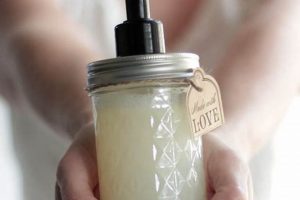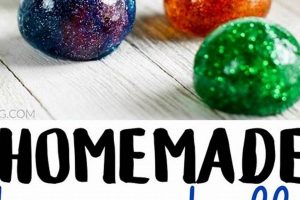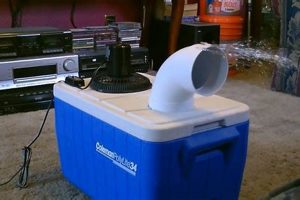A cleansing hair product, often created at home, removes buildup from styling products, hard water minerals, and environmental pollutants. This type of hair treatment aims to deeply cleanse the hair shaft, restoring its natural shine and manageability. An example includes mixing baking soda with water to create a paste applied to the hair.
The appeal lies in its potential to revitalize hair that has become dull or weighed down due to residue accumulation. Removing these impurities can improve the effectiveness of other hair care products and contribute to overall hair health. Historically, individuals have sought methods to purify and cleanse their hair using readily available natural ingredients, laying the groundwork for these contemporary homemade solutions.
The following sections will explore common ingredients, formulation techniques, and application methods for achieving a clarifying effect through homemade recipes, as well as cautionary measures to ensure the health and safety of the hair and scalp.
Tips for Formulating a Homemade Clarifying Hair Cleanser
Effective formulation requires careful consideration of ingredient properties and their potential effects on hair and scalp health. These tips offer guidance for creating a functional and safe product.
Tip 1: Prioritize Dilution: Concentrated ingredients can be harsh. Dilute solutions with water or other mild bases to minimize potential irritation and damage to the hair shaft.
Tip 2: Baking Soda Caution: Baking soda possesses a high pH, which can disrupt the scalp’s natural balance. Use sparingly and follow with an acidic rinse, such as diluted apple cider vinegar, to restore pH levels.
Tip 3: Understand Ingredient Interactions: Ingredients may interact unexpectedly. Research potential reactions before combining multiple components to prevent undesirable effects on hair texture or color.
Tip 4: Conduct a Strand Test: Before applying a homemade solution to the entire head, test a small, inconspicuous section of hair to assess its reaction and identify any adverse effects.
Tip 5: Avoid Harsh Surfactants: Conventional shampoos often contain sulfates that can strip hair of its natural oils. Opt for milder cleansing agents, such as castile soap, in a highly diluted form.
Tip 6: Hydrate and Condition: These types of cleansers can be drying. Follow with a deep conditioning treatment or hair mask to replenish moisture and prevent brittleness.
Tip 7: Frequency of Use: Overuse can lead to dryness and damage. Limit application to once or twice a month, depending on individual hair needs and the level of product buildup.
These guidelines facilitate the creation of a personalized cleansing treatment tailored to individual hair types and sensitivities, minimizing potential risks while maximizing the clarifying benefits.
The subsequent section will address common errors in homemade formulations and provide strategies for troubleshooting potential issues.
1. Ingredient Selection
The success of a clarifying hair cleanser depends significantly on the careful selection of ingredients. The choice of components directly influences the treatment’s efficacy in removing buildup, its impact on hair health, and the overall safety of the formulation.
- Cleansing Agents
The primary function of a clarifying hair product is to cleanse. Ingredient selection must center around agents capable of dissolving and removing residue without causing excessive damage to the hair shaft. Examples include diluted apple cider vinegar, known for its mild acidity, and castile soap, a gentle surfactant derived from vegetable oils. The concentration of these agents requires precise calibration; excessive amounts can strip the hair of essential oils, leading to dryness and breakage, whereas insufficient quantities may prove ineffective in removing stubborn buildup.
- pH Adjusters
Maintaining the appropriate pH level is crucial for hair health. Ingredients with a high pH, such as baking soda, require careful management. While baking soda can effectively remove residue, its alkalinity can disrupt the scalp’s natural balance. The inclusion of pH adjusting agents, such as diluted lemon juice or apple cider vinegar rinse, becomes necessary to restore the scalp’s acidity and prevent damage to the hair cuticle.
- Hydrating Components
Clarifying treatments, by their nature, can be drying. Therefore, incorporating hydrating elements is vital to counter the potential loss of moisture. Ingredients like aloe vera gel, honey, or glycerin can help replenish hydration and prevent the hair from becoming brittle. These components serve as humectants, drawing moisture from the environment into the hair shaft, thereby mitigating the drying effects of the cleansing agents.
- Additives and Preservatives
While not strictly essential, the inclusion of additives like essential oils can offer additional benefits, such as antimicrobial properties or a pleasant fragrance. However, caution is necessary; some essential oils can irritate the scalp or cause allergic reactions. The absence of preservatives in homemade formulations necessitates careful storage and prompt use to prevent bacterial growth.
In summary, the thoughtful selection of ingredients constitutes a foundational step in creating an effective and safe clarifying hair treatment. Balancing cleansing efficacy with pH regulation, hydration, and potential additives determines the overall outcome and ensures the health and vitality of the hair. Ignoring these considerations can lead to adverse effects, negating the intended benefits of the clarifying process.
2. pH Balance
pH balance is a critical consideration in formulating homemade clarifying hair cleansers. Disruptions to the scalp and hair’s natural pH can lead to a range of issues, including dryness, irritation, and damage to the hair cuticle. Therefore, understanding and managing pH levels is essential for safe and effective application.
- Natural pH of Hair and Scalp
The human scalp and hair typically maintain a slightly acidic pH, generally between 4.5 and 5.5. This acidity helps to keep the cuticle closed, promoting smoothness, shine, and preventing excessive water absorption. Maintaining this balance is crucial for overall hair health. Disrupting this delicate equilibrium can lead to a cascade of negative effects.
- Impact of Alkaline Ingredients
Many ingredients commonly used in DIY clarifying treatments, such as baking soda, are alkaline with a high pH. When applied to the hair and scalp, these alkaline substances can cause the hair cuticle to open, making the hair more porous and susceptible to damage. Repeated exposure to high pH can lead to dryness, brittle
ness, and breakage. - Acidic Rinses and pH Correction
To counteract the effects of alkaline ingredients, an acidic rinse is often recommended. Diluted apple cider vinegar or lemon juice can help restore the scalp and hair to its optimal pH range. These acidic rinses help to close the hair cuticle, smoothing the hair shaft and improving its overall condition. The concentration and application of these rinses must be carefully controlled to avoid over-acidifying the hair.
- Measuring and Monitoring pH
For individuals regularly creating homemade clarifying solutions, the use of pH testing strips can provide a valuable means of monitoring the pH levels of their formulations. This allows for precise adjustments to be made, ensuring that the final product falls within the acceptable pH range. Consistent monitoring helps to minimize the risk of pH-related damage to the hair.
The interplay between pH balance and homemade clarifying treatments directly affects the health and appearance of the hair. Ignoring pH considerations can inadvertently cause more harm than good. Careful selection of ingredients, understanding their pH properties, and implementing appropriate corrective measures are fundamental to creating a clarifying treatment that effectively removes buildup while preserving the integrity of the hair.
3. Dilution Necessity
The creation of homemade clarifying hair cleansers often involves ingredients with potent properties. These ingredients, while effective at removing buildup, can be excessively harsh in concentrated forms. Consequently, dilution becomes a critical step in the formulation process. Failure to adequately dilute ingredients may result in adverse effects, including scalp irritation, hair dryness, and potential damage to the hair cuticle. For example, concentrated apple cider vinegar, while a popular clarifying agent, can cause chemical burns if applied undiluted to the scalp. Dilution, therefore, serves as a crucial safety measure.
Beyond safety, dilution also influences the overall efficacy of the treatment. Excessively concentrated solutions can strip the hair of its natural oils, leading to a rebound effect where the scalp overproduces oil to compensate. This negates the intended clarifying effect. Proper dilution allows the cleansing agents to effectively remove buildup without disrupting the scalp’s natural balance. A practical example is the use of baking soda; a diluted solution effectively lifts residue, while a concentrated paste can leave the hair feeling dry and brittle. Furthermore, dilution ensures more even distribution of the active ingredients across the hair and scalp, promoting uniform cleansing and minimizing localized irritation.
In summary, the necessity of dilution in homemade clarifying formulations stems from both safety and efficacy considerations. It mitigates the potential for irritation and damage associated with concentrated ingredients, while also ensuring that the treatment effectively removes buildup without disrupting the scalp’s natural oil production. This understanding highlights the importance of careful adherence to recommended dilution ratios when preparing these types of treatments, contributing to improved hair health and minimizing potential adverse reactions.
4. Application method
The application method is integral to the effectiveness and safety of any homemade clarifying hair product. The manner in which the solution is applied directly impacts its ability to remove buildup and its potential to cause irritation or damage. For instance, uneven application might result in some areas being over-treated while others remain insufficiently cleansed. Likewise, leaving a potent clarifying solution on the scalp for an extended period, beyond recommended guidelines, can lead to dryness or chemical burns. Therefore, the application method dictates whether the treatment delivers the intended clarifying benefits or compromises hair health.
Practical examples further illustrate the importance of proper application. A clarifying solution containing baking soda requires thorough and even distribution to ensure uniform cleansing. The scalp and hair should be completely saturated, with particular attention paid to areas prone to buildup, such as the roots. Following application, a gentle massage can help to loosen residue. Critically, the solution must be rinsed out meticulously to prevent any residue from remaining on the hair or scalp, which could cause irritation. Similarly, the application of an acidic rinse, like diluted apple cider vinegar, needs to be performed thoroughly to neutralize any remaining alkalinity from the initial cleansing agent.
In conclusion, the application method represents a critical component of any clarifying hair treatment. It determines the efficacy of the cleansing process, impacts the potential for irritation or damage, and dictates the overall outcome. Careful attention to proper techniques, including even distribution, gentle massage, thorough rinsing, and neutralization of alkaline ingredients, is essential to maximize the benefits and minimize the risks associated with homemade clarifying formulations. The success of a clarifying treatment hinges not only on the ingredients used, but also on how they are applied.
5. Frequency control
The effectiveness and safety of a homemade clarifying hair cleanser are intrinsically linked to the frequency of its use. While designed to remove buildup, overuse can strip the hair of essential oils, leading to dryness, brittleness, and potential damage. The correct application frequency varies depending on hair type, product usage habits, and environmental factors. For instance, an individual with oily hair who frequently uses styling products may require more frequent clarifying than someone with dry hair who avoids such products. Failing to regulate application frequency can negate the intended benefits, resulting in compromised hair health.
Practical examples demonstrate the significance of frequency control. Applying a homemade clarifying solution weekly to dry, color-treated hair is likely to cause excessive dryness and fading of color. Conversely, infrequent use of a clarifying treatment on oily hair with heavy product buildup may not adequately cleanse the hair. The objective is to identify a balance that effectively removes residue without compromising the hair’s natural moisture and structural integrity. Furthermore, the composition of the clarifying solution itself impacts application frequency; a milder solution with gentler cleansing agents may allow for more frequent use than a potent solution with harsh ingredients.
In conclusion, frequency control represents a critical aspect of utilizing homemade clarifying treatments. Balancing cleansing needs with the potential for damage requires careful consideration of individual hair characteristics, product usage, and the specific formulation employed. Adhering to appropriate frequency guidelines ensures that the treatment effectively removes buildup while preserving the hair’s health, manageability, and overall appearance. Disregarding this aspect undermines the purpose of clarifying and may lead to adverse consequences.
6. Post-treatment condi
tioning
Conditioning after the application of a clarifying treatment is a necessary step to replenish moisture and restore the hair’s natural balance. Clarifying, by nature, tends to remove oils and buildup, which can leave hair feeling dry and stripped. This necessitates a conditioning regimen designed to counteract these effects.
- Moisture Replenishment
The primary role of post-treatment conditioning is to replace lost moisture. Clarifying solutions often contain ingredients that strip the hair shaft of its natural oils. Conditioning treatments counteract this by depositing hydrating agents, such as oils, humectants, and emollients, which help to restore moisture levels. Examples include deep conditioning masks with ingredients like shea butter, coconut oil, or hyaluronic acid, which penetrate the hair shaft and provide lasting hydration.
- Cuticle Smoothing
Clarifying can raise the hair cuticle, making the hair feel rough and prone to tangling. Conditioning agents help to smooth the cuticle, reducing friction and improving manageability. Ingredients like silicones, proteins, and acidic pH adjusters can help to flatten the cuticle, resulting in smoother, shinier hair. This step is crucial for preventing breakage and improving the overall appearance of the hair following a clarifying treatment.
- Protein Reinforcement
In some cases, clarifying treatments can weaken the hair’s protein structure. Conditioning treatments containing proteins, such as keratin or amino acids, can help to reinforce and strengthen the hair shaft. This is particularly important for individuals with damaged or chemically treated hair, as clarifying can exacerbate existing weaknesses. Protein-based conditioners help to rebuild the hair’s structure, improving its elasticity and reducing breakage.
- pH Balancing
Clarifying can sometimes disrupt the hair’s natural pH balance, leaving it more alkaline. Conditioning treatments can help to restore the hair’s optimal pH level, which is slightly acidic (around 4.5 to 5.5). Acidic conditioners help to close the hair cuticle and promote a smoother, healthier appearance. Ingredients like apple cider vinegar or citric acid can be used in conditioning rinses to help balance the pH.
In summary, post-treatment conditioning is an indispensable step following the use of clarifying cleansers. It addresses the potential drying and damaging effects of clarifying by replenishing moisture, smoothing the cuticle, reinforcing protein structure, and balancing pH levels. Properly executed conditioning ensures that the benefits of clarifying are realized without compromising the overall health and integrity of the hair.
Frequently Asked Questions
This section addresses common inquiries and misconceptions regarding the formulation and use of homemade clarifying hair cleansers. The information presented aims to provide a comprehensive understanding of the subject matter.
Question 1: What constitutes ‘buildup’ that necessitates a clarifying treatment?
Buildup refers to the accumulation of residues from styling products (gels, sprays, waxes), environmental pollutants, hard water minerals, and natural oils on the hair shaft. This accumulation can weigh down the hair, making it appear dull, lifeless, and difficult to style. It can also impede the penetration of other hair care products, reducing their effectiveness.
Question 2: Is it possible to use baking soda safely in a homemade clarifying treatment?
Baking soda possesses a high pH, which can be damaging to the hair if used incorrectly. Safe use requires careful dilution with water and a subsequent acidic rinse, such as diluted apple cider vinegar, to restore the hair’s natural pH balance. Frequent or undiluted use of baking soda is not recommended.
Question 3: What are the signs of an adverse reaction to a homemade clarifying treatment?
Signs of an adverse reaction may include scalp irritation (redness, itching, burning), excessive dryness, hair breakage, and changes in hair texture or color. If any of these symptoms occur, discontinue use immediately and rinse the hair thoroughly.
Question 4: How often should a clarifying treatment be applied?
The frequency of clarifying treatments depends on individual hair type, product usage habits, and environmental factors. As a general guideline, application should be limited to once or twice a month to avoid stripping the hair of its natural oils. Individuals who use styling products frequently may require slightly more frequent clarifying.
Question 5: Can essential oils be incorporated into homemade clarifying solutions?
Essential oils can be added for fragrance or potential therapeutic benefits. However, caution is advised. Some essential oils can be irritating to the scalp or cause allergic reactions. It is essential to use high-quality, diluted essential oils and to perform a patch test before applying the solution to the entire scalp.
Question 6: Are homemade clarifying treatments suitable for color-treated hair?
Clarifying treatments can potentially strip color from dyed hair. Individuals with color-treated hair should exercise caution and test the solution on a small, inconspicuous strand before applying it to the entire head. It may be necessary to reduce the frequency of clarifying or to use gentler clarifying agents to minimize color loss.
In summary, homemade clarifying treatments offer a viable option for removing buildup from hair. However, safe and effective use requires careful consideration of ingredients, pH balance, application method, and frequency. Awareness of potential risks and adherence to recommended guidelines are essential for achieving desired results without compromising hair health.
The next section will explore alternative clarifying methods and professional product recommendations.
DIY Clarifying Shampoo
This exposition has detailed various aspects of formulating a homemade clarifying hair cleanser. The examination spanned ingredient selection, pH balance, dilution necessities, application methodologies, frequency control, and post-treatment conditioning. Each element contributes significantly to the overall efficacy and safety of such treatments. The information provided emphasizes the importance of informed decision-making when undertaking homemade formulations to mitigate potential risks.
The principles outlined herein serve as a foundation for responsible experimentation in hair care. Consistent adherence to these guidelines promotes both the removal of unwanted buildup and the preservation of hair health. Further research and careful observation of individual hair responses remain crucial for optimal outcomes. The commitment to informed practice ensures that clarifying efforts contribute positively to overall hair maintenance regimens.







